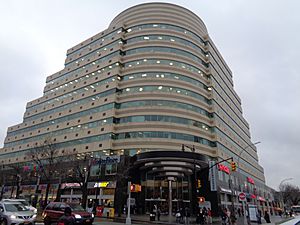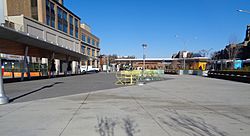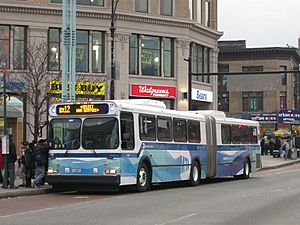Fordham Plaza, Bronx facts for kids
Quick facts for kids
Fordham Plaza
|
|
|---|---|

One Fordham Plaza
|
|
| Locale | Fordham, Bronx, New York |
| Rail services |
Harlem Line
New Haven Line
|
| Bus routes | New York City Bus: Bx9, Bx12, Bx12 SBS, Bx15, Bx17, Bx41, Bx41 SBS Bee-Line Bus System: B-L60, B-L61, B-L62 |
Fordham Plaza, once known as Fordham Square, is a very busy place in the Bronx, New York City. It's a major spot for both shopping and transportation. You can find it in the Fordham and Belmont areas.
The plaza is located on the south side of Fordham Road. It's near Third and Webster Avenues. This area is the eastern end of a big shopping street called "Fordham Center." It stretches past Grand Concourse and Jerome Avenue. To the west, you'll find the Bronx's Little Italy district on Arthur Avenue in Belmont.
Right across from the plaza is Fordham University's Rose Hill campus. The plaza is also above the Fordham station for the Metro-North Railroad. When people say "Fordham Plaza," they usually mean two main things. One is the office building called One Fordham Plaza. This building is on the east side of Third Avenue. The other is the Fordham Plaza Bus Terminal. This is a bus stop area and a walking space on the west side, above the train station. Fordham Plaza and the rest of Fordham Road's shops make up the biggest shopping area in the Bronx. It's also the third largest in all of New York City.
Contents
What is Fordham Plaza?
The name "Fordham Plaza" describes a two-block-long area. It's on the south side of Fordham Road. The area is between Webster Avenue to the west and Washington Avenue to the east. To the south, it borders East 189th Street. Third Avenue runs through the middle of this area to Fordham Road. Park Avenue used to run north through the plaza. Now, it stops at 189th Street.
Fordham Place and One Fordham Plaza Buildings
There are two main buildings in the plaza area. On the southeast corner of Fordham Road and Webster Avenue is Fordham Place. This building has a long history, dating back to the 1910s. It's made of brick and takes up half of the western block.
Fordham Place has a 7-story building and a taller 14-story building. Both have shops and offices. Stores like Best Buy are here. Until 2014, a Sears store was also here, which gave the building the nickname "Sears Building." Now, Macy's has taken over that space. This building was once known as the Roger's Building. It was named after the Rogers and Sons Department Store that was there before Sears.
The second important building is One Fordham Plaza. This is a 14-story office building. It covers the whole eastern block on Fordham Road and Washington Avenue. Famous architects from the Skidmore, Owings & Merrill firm designed it. The building has an "L" shape, with sides along Fordham Road and Third Avenue.
It looks like a "layer-cake" or "ziggurat" with yellow stone, black marble, and shiny chrome. The two sides meet at a dome on the corner of Fordham Road and Third Avenue. Its style is called "Neo Art Deco" or "post-modern." One Fordham Plaza opened in 1986. It has shops on its lower floors, including a T.J.Maxx. It also has health centers and a multi-level parking garage.
Bus Terminal and Public Space
Between the two main buildings is the Fordham Plaza Bus Terminal. This area is on Third Avenue. It's built over the Metro-North Railroad tracks like a bridge. From 1997 to early 2013, this spot was an outdoor market. It had cobblestone paths, tents, and stands selling things like fruit. There were also small food stands near the Metro-North station entrance.
The market and old bus areas were taken down between 2013 and 2016. This was part of the "Fordham Plaza Reconstruction Project." The new design created a bus loop on Third Avenue. This loop is used by the Bx15 buses. The street was also closed to all cars except buses. The project added a cafe and a cover over the Metro-North stairs. Another cover with food kiosks was built at the south end of the plaza. New signs were also put up to help people find their way around.
Nearby Attractions
Right across from the plaza to the north is Fordham University's Rose Hill campus. This includes the William D. Walsh Family Library and Fordham Preparatory School. Across Washington Avenue to the east is the Theodore Roosevelt Educational Campus. The Bronx Library Center is also nearby.
Fordham Plaza is close to several fun places in Bronx Park. These include the New York Botanical Garden and the Bronx Zoo. Fordham Plaza is part of the Fordham Road Business Improvement District. This district helps improve the shopping area, which is one of the biggest in the Bronx.
History of Fordham Plaza
Early Days and Growth
In the 1840s, the area where Fordham Road and Webster Avenue meet was mostly farmland. It was part of the town of West Farms. There were a few small homes and businesses. The Powell Farm House, one of the oldest homes, was built here around 1800. A boarding school was also on the farm.
Major changes began when St. John's College (now Fordham University) opened in 1841. After 1849, the farm land was divided up. A train station for the New York and Harlem Railroad (now Metro-North) was built by 1850. In the late 1800s, the Bronx Zoo and New York Botanical Garden opened nearby.
The Third Avenue El (an elevated train) was extended to Fordham Road in 1901. Streetcar service also started in the late 1800s and early 1900s. These changes caused the population to grow very fast. Fordham Road became a major shopping area by the early 1900s.
Creating the Plaza
Around 1911, people started planning to create Fordham Plaza as a park or a new development. In 1912, city engineers planned to build a plaza between Third and Park Avenues. This involved covering the train tracks to create the open space.
In 1916, the Francis Rogers & Sons Department Store bought a block to build a new store. This store, which opened in 1919, became 400 East Fordham Road. The plaza itself was built in the 1920s. This happened along with updates to the train station, which finished in 1926. By 1938, maps showed the name "Fordham Plaza" for the area above the Metro-North tracks. In 1943, the area was changed to be a retail district. The goal was to make it the "Times Square of the Bronx."
In the 1960s, the United States Postal Service (USPS) wanted to build a new main post office for the Bronx here. This project was planned to be a large federal building. However, the plan did not happen due to political reasons.
Modern Updates
In 1973, the Third Avenue El train line was closed. This was partly to help develop areas like Fordham Plaza. The elevated tracks were removed by 1977. Also in 1973, there were plans for a new shopping complex called Fordham Plaza Development. This project aimed to bring new businesses and offices to the area. However, it faced delays and was eventually stopped in 1981.
In 1981, a Sears store opened in the old Rogers Department Store building. In 1984, construction began on One Fordham Plaza. This was a new office building, the first of its kind in the Bronx in over 25 years. It was built on land that had been empty for more than ten years. The building was finished by 1985 and opened in August 1986. It cost about $65 million. When it first opened, many city and state offices rented space there. By 1991, almost all the offices were rented.
Before the 1990s, the area that is now the Fordham Plaza Bus Terminal was a market and parking lot. In the 1980s, people suggested turning it into a bus terminal and public space. Construction started in 1995. The plaza was paved with cobblestones, and new bus shelters were added. It officially opened on August 28, 1997.
In 2004, the Sears Building was bought by new owners. In 2005, they announced plans to make it bigger. In 2007, work began on expanding the complex, which was renamed Fordham Place. This project added a new 14-story building. The Sears store closed that year because of the construction. The new Fordham Place opened in February 2009. It brought new stores like the first Best Buy in the Bronx and a Walgreens pharmacy.
In 2007, Mayor Michael Bloomberg introduced the PlaNYC 2030 plan. This plan included updating Fordham Plaza's bus terminal and market. The goal was to make it brighter, safer, and have more public space. The project received money from the United States Department of Transportation. Construction began in February 2013. The new bus loop was finished in 2014. The entire renovated plaza opened to the public on January 20, 2016.
Getting Around Fordham Plaza
Many bus routes stop at or near Fordham Plaza. There are twelve New York City Bus local routes. Also, three routes from the Bee-Line Bus System (which serves Westchester County) stop here. These include the Bx12 and Bx41 Select Bus Service routes. These special buses run along Fordham Road and Webster Avenue.
Only two bus routes, the Bx15 and Bx17, actually stop inside the plaza's bus terminal area. The Bx15 is the only one that uses the bus loop.
The plaza is located right above the Metro-North's Fordham station. This is one of the busiest stations in the Metro-North system. The main entrance to the station is across Fordham Road. There's also another entrance inside the bus loop. This entrance has two stairways that lead to the train platforms.
After the Third Avenue El train closed in 1973, the closest subway stop to the plaza is the Fordham Road station. This station is part of the IND Concourse Line. It's about six blocks west of the plaza.





